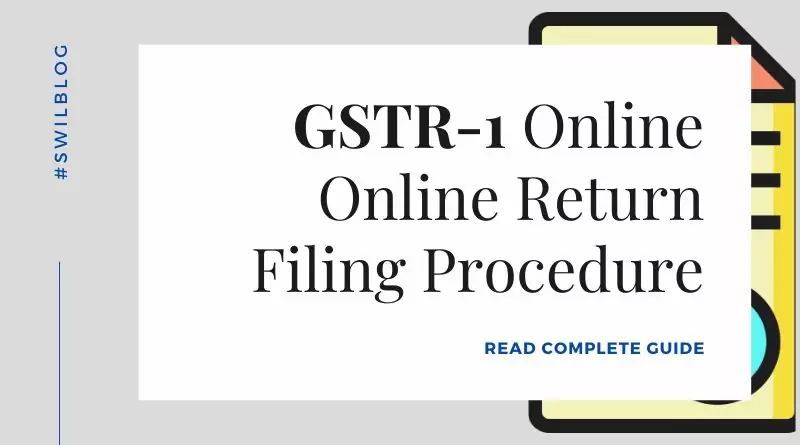We all are part of an economy and contribute to improving it in various ways-indirect and direct ways. Taxation is a major part of it. On-time payment of taxes makes you a responsible citizen.
We are all aware that the advent of GST taxation has led to major tax reform in India. It has given a new direction to all types of taxes that were put on different products or services by the Central and State Governments. This way, it implements one tax system in India.
The establishment of the GST taxation system has gone to streamline many of the taxes levied on products, which comes with a facility for both taxpayers and tax collectors. It also makes filing taxes easier because taxpayers only have to file for one tax.
Understand GST return: Important Terms to Know in GSTR-1
Before going into the process of GST filing, it is very important to understand the role of GST return. Along with this, you should also know what GST returns mean for business owners and service providers.
The GST return is mandatory for filing all businesses that come under the GST regime. Every person who pays tax under the GST Act should verify his income with the Tax Department of India. This is known as GST return and includes details of every sale and purchase.
Under this system of taxation, the individuals concerned have to file their GST returns 26 times a year. While business owners have to go twice every month to file Goods and Services Tax, they must also file two additional times semi-annually.
The process of filing GST returns involves several types of return types that are required to be known and understood. Such as GSTR-1, GSTR-2, GSTR-3,… to GSTR-11.
However, we have prepared this blog especially for GSTR-1 and have given solutions to the issues related to it.
Quick View on Latest Updates on GSTR-1
1st February 2023
Updates to the 2022 budget
According to an amendment to Section 37 of the CGST Act, taxpayers are not permitted to file GSTR-1 after three years have passed since the relevant GSTR-1 due date for a tax period.
26th December 2022
The following new tables are added to the GSTR-1 format:
(1) Reporting ECO operators’ GSTIN-wise sales through e-commerce operators for which ECO operators are required to collect TCS under Section 52 or are required to pay tax under Section 9(5) of the CGST Act
(2) For suppliers: Table 14A, Table 14 Amendments
(3) For e-commerce companies, Table 15 – Reporting both B2B and B2C suppliers’ GSTIN-wise sales through e-commerce companies, on which e-commerce companies shall deposit TCS under Section 9(5) of the CGST Act
(4) Table 15A for e-commerce operators
-Sales to GST-registered persons: Table 15A I Amendments (B2B)
-Changes to Table 15 for sales to unregistered people (Table 15A II) (B2C)
February 1 2022
Updates to the 2022 budget
(1) The September return filing deadline has been replaced by November 30 of the following year, or the filing of the annual return, whichever is earlier, as the final date for changes, corrections, and uploading of missed invoices or debit/notes of one financial year.
(2) The revisions also mandate tax period-by-tax period sequential filing of outward supply details.
December 21 2021
(1) As of January 1, 2022, taxpayers who failed to file GSTR-3B for the prior period are not permitted to file GSTR-1.
(2) Beginning on January 1, 2022, the GST officers may begin recovery actions against taxpayers who underreport sales in GSTR-3B in comparison to GSTR-1 without giving them a show-cause notice.
Basics of GSTR-1
When it comes to filing your taxes, GSTR 1 is one of the most important tax forms. This is because the information you entered under GSTR 1 is used as a base to be auto-populated for all other tax forms. Therefore, you have to fill it very carefully.
GSTR-1 is a monthly or quarterly return filed by each registered dealer in connection with the trade. It contains details of all outward supplies of goods, which means sales. It means that anyone involved in the journey needs to specify details related to the supply and also to the recipient. To understand it better and comply with the GST norms, read on GSTR-1 for more information.
Who should file GSTR-1?
Every registered business owner/dealer is responsible for filing GSTR. It shows transactions and sales for a particular month. Even as there are no sales or transactions, you, as a registered dealer, will have to file GSTR-1. For nil GSTR-1 filers, there is a facility to file through an SMS that started from the 1st week of July 2020.
Below are some individuals/entities that are exempt from filing GSTR-1.
- An input service distributor (ISD): If your business receives invoices for services used by your branches, you fall in the category of an input service distributor under GST.
- Composition dealer: You are a composition dealer if you have registered your business under the composition scheme of GST. From 1st April 2019, businesses with an annual turnover of up to Rs. 1.5 crore can opt for the composition scheme.
- A supplier of online information, database access, or retrieval services
- Non-resident taxable person: You fall under the category of a non-taxable resident person if you import goods and services from outside India or are in charge of managing the business on behalf of a non-resident Indian (NRI).
- A taxpayer liable for collecting tax at source (TCS) or a taxpayer liable for deducting Tax at Source (TDS)
When is GSTR-1 due?
The due dates for GSTR-1 are based on the company’s turnover.
- The due dates for GSTR-1 are based on the company’s turnover.
- If the companies’ sales are up to Rs. 5 crores, they must be submitted by the 13th of the month after the relevant quarter. For this, they can submit quarterly returns under the QRMP system.
- The return must be submitted each month by the 11th of the next month for taxpayers who do not choose the QRMP plan or who have a total annual revenue of more than Rs. 5 crores.
Let’s understand this clearly with the following table:
| For businesses (with turnover) | Month/Quarter | Due Date |
| October 2022 | 11th November 2022 | |
| November 2022 | 11th December 2022 | |
| December 2022 | 11th January 2023 | |
| January 2023 | 26th February 2023 | |
| February 2023 | 11th March 2023 | |
| March 2023 | 11th April 2023 | |
| Turnover up to Rs.5 crore (QRMP Scheme) | Oct-Dec 2022 | 13th January 2023 |
| Jan-Mar 2023 | 13th April 2023 |
How to revise GSTR-1?
Returns once filed, cannot be modified. Any mistake made in the return can be rectified in the GSTR-1 filed for the next period (month/quarter). Therefore, it needs more concern when filing GSTR-1.
What is the penalty for late GSTR-1 filing?
As per GST law, GSTR-1 has to pay late fees for late or not filing. This late fee is 200 per late day (Rs 100 as per CGST Act and Rs 100 per SGST Act). The late fee is paid from the date after the due date.
However, as per the latest information, the late fee has been reduced to Rs. 50 per day and per day (for zero returns).
As per GST law, GSTR-1 has to pay late fees for late or not filing.
The following table explains the latest late fee to be charged (for other than nil GSTR-1 filing cases):
| Act Name | Late fees for every day of delay | Maximum late fee (if the annual turnover in the previous financial year is up to Rs.1.5 crore) | Maximum late fee(If the annual turnover ranges between Rs.1.5 crore and Rs.5 crore) | Maximum late fee(If the turnover is more than Rs.5 crore) |
| CGST Act, 2017 | 25/- | 1,000/- | 2,500/- | 5,000/- |
| Respective SCGT Act, 2017 / UTGST Act, 2017 | 25/- | 1,000/- | 2,500/- | 5,000/- |
| TOTAL LATE FEES TO BE PAID | 50/- | 2,000/- | 5,000/- | 10,000/- |
Following are the latest late fee to be charges for other than nil GSTR-1 filing cases:
| Act Name | Late fees for every day of delay | Maximum late fee |
| CGST Act, 2017 | 10/- | 250/- |
| Respective SCGT Act, 2017 / UTGST Act, 2017 | 10/- | 250/- |
| Total late fees to be paid | 20/- | 500/- |
What documents do you need to enter GSTR 1?
- A valid and genuine Goods and Services Tax Identification Number (GSTIN)
- User ID and password to sign in to the portal
- Aadhaar number (if you are going to e-sign the form)
- Access to the mobile number mentioned in your Aadhar card
- A valid Digital Signature Certificate (DSC) (unless you can e-sign the form as per your classification as a supplier)
What should you keep in mind in filing GSTR-1?
Filing returns for business is also a matter of attention because GST is still difficult for many businesses to understand. With the help of GST software, it becomes an easy process. But while entering GSTR-1, you have to take care of a few things.
- Make sure you have entered the correct GSTIN code and HSN code
- Confirm whether the transaction falls under Inter-State or Inter-State category.
- You can change the uploaded bills many times, but after the return is submitted, you will not be able to change the invoice, so take care in filing the invoice.
- Once you submit, you cannot modify the return but you can make any correction in the next month’s GSTR-1.
- GSTR-1 is part of GST registration and GST return filing.
- Upload invoices at various intervals during the month to avoid bulk uploads
- Companies such as LLP (Limited Liability Partnership) and FLLP (Foreign Limited Liability Partnership) are obliged to provide Digital Signature Certificate (DSC).
- Suppliers like proprietors, partnerships, HUF, and others can e-sign GSTR-1.
- You can use third-party software to file GSTR 1 directly.
How can SwiLERP Software help you in the online GST return filing procedure?
SwilERP comes with all the advanced features and options that help the businessman in filing GST returns. Importing and downloading GST data functionality for the preparation of GST returns also becomes easy through SwilERP.
The software offers various options that help its users prepare their report for GSTR-1 filing in a few clicks or minutes. It provides useful insights under the ‘Reports’ section so that any business owner can have a hassle-free journey of GST compliance.
With SwilERP, a user has to import sales data for GSTR-1 just once. Based on this, the software auto-populates in GSTR-3B at the click of a button.
Also, the user gets a real-time update of the GSTR-1 filing. The user can also sort the invoice level data of GSTR-1 filed during different time periods and download it in Excel form for further use.
Thus, the person can avoid errors and ensure 100% accuracy in reporting data with minimal manual intervention. Thus it declares accuracy all the way.
SwilERP advantage on filing GSTR-1
- It eliminates manual working or calculation and facilitates 100% accurate returns filing.
- It tracks the filing status of your business and alerts you about your dates and dues.
- The software consists of end-to-end filing on a single portal with EVC or DSC.
- It has a feature that imports Tally data with a single click.
- It has a feature that Import invoice data in any format.
How to file GSTR-1 on SwilERP GST Software?
Filing on SwilERP GST Software is simple and quick. Here is a detailed guide to file GSTR-1 on SwilERP Software. Let’s have a look into the procedure of filing GSTR 1 in detailed format–
For more in-depth knowledge on GSTR-1, kindly see-
- https://support.swildesk.com/portal/en/kb/articles/how-to-export-gstr1-in-csv-excel-format
- https://support.swildesk.com/portal/en/kb/articles/retailgraph-gstr1-excel-and-csv-export-and-upload
For more information and assistance, kindly visit our website swindia.com for a demo or call us. Our experts will surely help you to know How to File GSTR-1.
FAQs (Frequesntly Asked Question)
Even if there are no monthly sales, should I still file GSTR-1?
Absolutely yes, even if there were no sales during a month or quarter, submitting GSTR 1 is still required.
In this situation, you must submit a Nil GSTR-1.
Can I only upload an invoice when submitting a return?
Invoices can be uploaded at any time. To reduce bulk uploads while completing a return, you are strongly encouraged to upload invoices regularly throughout the month. This is due to the lengthy bulk upload process.
Can I edit an uploaded bill or invoice on the GST portal?
You can edit bills several times after uploading them. After an invoice is uploaded, it can be changed at any time. Nevertheless, you can only change an invoice before sending in a return. The figures are locked once they are submitted.
Should I pay my Tax after submitting GSTR-1?
GSTR-1 is a return used to report sales information to the government.
As a result, after filing this return, no tax is due. You must, however, pay the Tax owed and submit GSTR-3B.
Can I submit my GSTR-1 after it has been due?
You can submit the GSTR-1 even after the deadline, yes. Yet you must pay a late fee determined by the days your payment was delayed.







